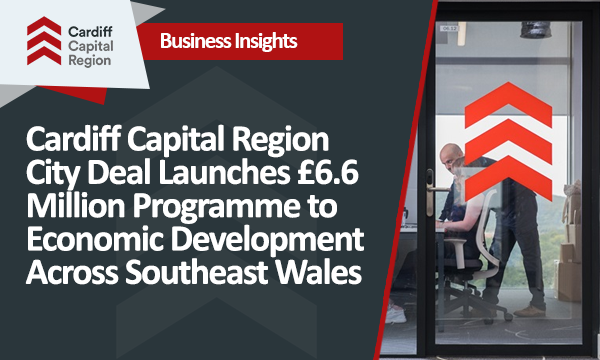Last week, we introduced our series of Energy and Sustainability features with an overview of the challenges that lie ahead in delivering a net-zero carbon emissions region by 2050 – and the immense economic and social opportunities that can be grasped if we achieve our aims. The scale and pace of transformation towards these goals is quite literally breath-taking, with new initiatives and programmes emerging on an almost daily basis.
Even in the past week, Dwr Cymru Welsh Water has announced its plans to achieve net zero emissions by 2040; and Chancellor Rishi Sunak opened the new UK Infrastructure Bank, making billions of pounds available to UK businesses and communities supporting local growth and tackling climate change. The future has already started; and Cardiff Capital Region (CCR) is putting in place the action plan that will position us at the very front of this new age.
The future has already started and CCR is putting in place an action plan for this new age
In February this year, we began the Cardiff Capital Region decarbonisation and sustainability journey in earnest, unveiling our Energy Vision and Strategy: a pioneering partnership between CCR and the Welsh Government Energy Service (WGES), dedicated to transforming the way energy is generated, transported and utilised in South East Wales – focused on making the step changes that are essential to meeting our zero carbon targets by 2050. Those changes will affect every aspect of our lives, with Kellie Beirne, Director of Cardiff Capital Region City Deal, seeing this transformation as a major part of enhancing health and wellbeing in every community across the region, as well as supporting a just transition to a clean growth economy that protects the environment for future generations, with Kellie emphasising that,
“the options and choices put in front of us have been stark and there’s a consensus across the region that decisions need to be made now.”
The emerging plan will scope the Implementation Priorities for the region
The plan emerging from those decisions will scope the first ‘Implementation Priorities’ for the region, recognising the interlinked characteristics of climate crisis, historic low growth plus the impetus to build back better – and greener. Much of that plan has already been reflected in the ‘requirements and results’ embedded in the CCR Prosperity for our Place investment prospectus, which showcases the potential for a transformative programme of activity that offers according to Huw David, the CCR Regional Cabinet Board Member responsible for the environment, air quality and sustainable transport;
“the opportunity to build upon the region’s unique natural energy generating assets – and use the strength of our existing manufacturing base as a springboard for a transition to a hydrogen economy, with the creation of multiple Clean Growth hubs.”
The potential to create 75,000 jobs and a £7.2bn uplift in GVA across CCR
The BEIS sub-regional data for 2019 gives credence to Huw David’s cautious optimism – showing the potential for decarbonisation to create 75,000 jobs and a £7.2bn uplift in Gross Value Add across CCR. How can such dramatic economic growth be achieved? The answer lies in the fact that our region uses 33 terawatt hours each year through heat, electricity, transport and fuel. To put this in perspective, Mid Wales uses 5 terawatt hours – showing in sharp relief the hive of economic and consumer activity across CCR. Only one sixth of this activity comes from renewable energy (predominantly electricity) and the task of decarbonising the remaining five sixths (at a cost of £8.2 billion) would create those extra jobs and that increased GVA.
Pillars for an Actionable Plan
To meet the declared targets, CCR needs a 55% reduction in emissions from its energy system by 2035 – achievable through a combination of a 51% decrease in domestic heat and power, a 54% reduction in commercial and industrial sectors and a 60% reduction in road transport emissions. An actionable plan is currently in the process of being created to achieve these targets, with key potential pillars already in place, including:
Our new CCR Investment Prospectus- Prosperity for our Place: Contains proposals centred on domestic and commercial retrofit, hydrogen generation and harnessing tidal power.
A Challenge Funded Energy Mission: CCR has successfully pioneered an innovative Challenge Fund approach that responds directly to problems posed by societal and behavioural factors – and has the ‘proven template’ to develop an Energy Mission capable of addressing a myriad of energy challenges.
Alignment with UK Government’s 10-Point Plan: UK Government’s recent “10 Point Plan for a Green Industrial Revolution” offers CCR the opportunity to align with wider R&D and Infrastructure investments, in the spirit of using low carbon energy as an enabler of economic regeneration, to generate ‘clean’ regional income that protects our environment.
Innovation: New low carbon energy technologies are emerging at a rapid pace – enabling us to benefit communities across CCR, through programmes such as the Smart Living Initiative and the Welsh Government Demonstrator ‘place-based and needs-led’ projects that can position us as a ‘catalyst of change’, particularly in low-carbon transportation.
Building Back Better: Already one of the key ‘5 for 5’ priority areas for CCR, our ‘Build Back Better’ objectives place a strong emphasis on embedding energy imperatives into our activity plans.
Evolution towards a CJC: Our move towards regional economic governance naturally opens up opportunities for regional public investment on a wider scale, for R&D, Infrastructure, the new Shared Prosperity Fund, and the £12bn Green Industrial Revolution Fund and for a revised Industrial Strategy.
Transport Strategy: Our MetroPlus. LEV Taxi Strategy, £1.3m ULEV procurement, regional electric bus feasibility study and other local transport programmes all contain an element of carbon reduction and core energy development.
Continual Engagement: Changing behaviours take continual communication and convincing engagement – and our wide-ranging engagement strategy will continue to focus on developing data-based evidence that the CCR Energy Vision will produce greater GVA and net jobs than a BAU scenario.
In the spirit of that evidence-based engagement, we asked Rob O’Dwyer, Head of Infrastructure for CCR, to bring us up to speed on the actions taken over the last few months since the Energy Vision & Strategy was announced.
The Progress of our Plan
“Working in partnership with WGES and the Carbon Trust, we’ve spent the past 18 months or so collating a huge amount of data and have created a Strategic Steering Group selected from individuals across the region, representing organisations such as the South Wales Industrial Cluster and Natural Resources Wales as well as the local authorities, to review all the information we now have at our fingertips” explains Rob. “This steering group will oversee the development and implementation of our strategy. Beyond that, we have also established four critical streams underpinning the steering group – consisting of experts in the Transport, Industrial & Commercial, Renewables and Domestic sectors – and we’re now in the process of aligning our top-down strategic analysis with bottom-up reporting on the activity currently happening on the ground in both the public and private sector.”
A Strategic Steering Group informed by experts in Transport, Industrial & Commercial, Renewables and Domestic sectors
Rob continues, “We’re currently running a series of thematic workshops in each of the four streams to identify the pathways forward and the long lists of actions and interventions that will help us to achieve our shared vision. Those actions may include traditional capital projects and programmes, but could also identify a need for further R&D, project development, education programmes, supply chain development or lobbying for policy change. It’s our intention to pull all of this together in a coherent, costed, and joined- up plan of action for South East Wales capable of attracting appropriate levels of investment.”
We need an initial £8.6bn investment to reach our 2035 goals
“Ultimately, our plan will involve a series of interventions to ensure we are on track to reduce emissions from our energy system by 55% by 2035 and net-zero by 2050.
£8.6 billion spend will required to achieve our energy vision by 2035. This cost will be offset by the potential for in excess of 70,000 jobs being created in the electricity and heating sectors and over £7 billion additional GVA. In order to prepare a plan of this magnitude we will be working in partnership with Flexis Wales, a university collaboration which will provide capacity around early R&D in the region and demonstrator zones.
“There are immediate opportunities of course, some of which had already been scoped in our detailed Energy Prospectus and in the wider CCR Investment Prospectus- Prosperity for our Place. We’ve launched our Decarbonisation-themed Challenge Fund, focused on creating a centralised carbon-neutral fleet for all ten local authorities; and we are working with local authority partners, Cardiff University and the Knowledge Transfer Network to scope many more challenge led propositions. These Challenges are fertile ways to produce innovative solutions with maximum benefits, with the opportunity to quickly scale up a solution once it’s proven” says Rob.
The Challenge Funds produce innovative solutions delivering maximum benefits
Immediate energy implementation priorities are currently being informed by continued support from the Welsh Government Energy Service, Carbon Trust, CCR Energy Steering Group and partners such as Flexis and CS Connected. Early opportunities are focussed on:
Decarbonisation of Transport – Metro Plus, Metro Central, CCR ULEV and ‘try before you buy’ schemes, role of InFuSe in building innovation capacity within public services and the LEV Fleet Challenge and potential around a hydrogen demonstrator fund;
Commercial and Industrial Decarbonisation – energy provision for R&D Clusters, development of the STEP Fusion Nuclear Prototype Project, developing the region’s capacity for a Gigaplant and supporting the work of SWIC;
Domestic – preparing a business case in application-format for the scoping of a region-wide Optimised Domestic Retro-fit Programme and utilising the local wealth building challenge fund to develop the private sector domestic retro-fit proposal;
Renewable Energy – developing the framework for local energy generation schemes and support for the WG-PIN notice for tidal development projects which could link to many of the wider initiatives set out above.
“we’re having very encouraging conversations in other channels too, regarding the decarbonisation potential of a Free Port in our region; as well as the possibility of Bridgend College becoming a centre for a green economy skills curriculum – and we’ve also teamed-up with the Vale of Glamorgan to bid through the UK Government STEPS Programme for a pilot nuclear fusion plant at Aberthaw Power Station. Our bid has a real differentiator as it would power a Digital Gigaplant for the region, as well as deliver carbon free energy for the grid and we were delighted to hear last week that the Aberthaw Power Station site has been shortlisted by UK Atomic Energy Agency as one of 15 preferred sites in the UK. We’ve also put forward an Expression of Interest to create a tidal lagoon at Aberthaw, as its geography and geology are perfect for that type of facility – and it’s this type of thinking which is now needed to grasp all the opportunities on offer” Rob emphasises.
A CCR Energy Agency may be the next key evolution
With CCR already signed up to be at COP26 for the full two weeks in November – and also exploring entering the Race to Zero initiative as our cop 26 pledge – the last few months have seen an intense period of activity, with eyes firmly set on making the most of this unique moment in time.
“Above all, we need to quickly identify the next stage of governance structure, to both embed a regional energy strategy and make it happen” stresses Rob.
“We don’t quite know exactly what it will look like right now, but we have benchmarked across the UK and had many illuminating conversations, especially with Manchester, where they have put a bespoke Energy Agency in place to deliver everything. A CCR Energy Agency that takes responsibility for both high level strategy and the operational chalk-face delivery across all four streams, could well be the next key evolution.”










